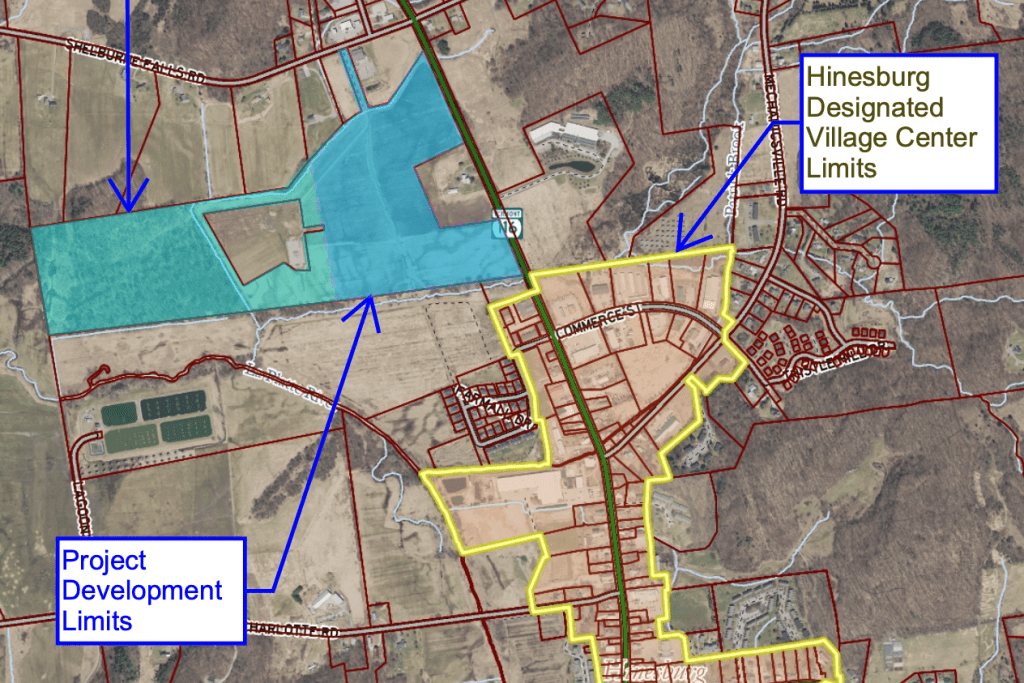A map outlining the boundaries of Hinesburg’s largest development to date — Haystack Crossing. Image courtesy of the Vermont Agency of Natural Resources
In the works for a decade, Hinesburg’s largest development project received its Act 250 permit last week.
Alex Weinhagen, the town’s director of planning and zoning, said he is excited about the long-awaited approval for Haystack Crossing – a 76-acre mixed-use development off Route 116. “It means a lot because this project has already received its local level town approvals, and the Act 250 review has taken a very long time.”
The first conceptual plan was submitted – and denied by the town – in 2014. After several denials, revision and a public process, the Hinesburg Development Review Board approved the project in November 2022, according to information posted on the town website.
According to the project plans, the first phase of Haystack Crossing is slated to bring almost 200 units of housing to the Chittenden County town of roughly 4,700 people. A second phase would bring the total to nearly 250.
“There’s been a lot of talk in Vermont over the last couple of years about our housing crisis and the need to increase housing supply. Well, this is Hinesburg shouldering its burden and being a part of the solution,” Weinhagen said.
The project developer, BlackRock Construction, LLC, outlined in its Act 250 application a multi-phased plan on undeveloped land owned by the Bissonette family, west of Route 116 and north of Kinney Drugs in town.
The first phase of the plan entails building 176 single-family, multi-family, and senior housing units and 27,000 square feet of commercial or light industrial space, as well as green space throughout the property.
Once all phases are complete, the project would feature 50 congregate care units for seniors and 139 other residential units, including single-family homes, attached townhouses and units in mixed-use buildings.
Documents submitted to the state estimate the project will result in more than $1.2 million in state and local tax revenues.
The large development will change the rural look of the village area when entering from the north and will help connect the town, library and banks and businesses to the north via sidewalks, bike paths and interior roads, according to Weinhagen.
“So it’s definitely going to look different but my hope is that it’s going to provide a really wonderful connection” to the village, he said.
The developers did not immediately respond to an interview request but in the permitting documents, they estimated a construction schedule of 10 years. Weinhagen said construction could potentially begin this fall.
“It’s clearly a multi-million dollar development, just from the infrastructure costs of putting in the roads and sidewalks and water and sewer lines,” he said.
There is a monthlong period during which the Act 250 permit can be appealed, but the public process didn’t feature major opposition, according to Weinhagen.
He noted that there were some traffic and congestion concerns, mostly because the development is not close to current homes and includes farmland. Instead, town officials have heard from folks interested in when they can apply to live there.
A site plan of the 76-acre Haystack Crossing development in Hinesburg. Image courtesy of the Vermont Agency of Natural Resources
“Thankfully, this project is one that I think most people can get behind in terms of the diversity of housing that’s being proposed,” he said.
Hinesburg resident Richard Bigue said he’s concerned about new residents burdening the already crowded school system and the development bringing additional traffic, especially on Route 116, where he said there can be a 20-minute wait to travel 2 miles at peak hours.
“It is very congested,” he said. “The Haystack project, if done right, could pull some of that traffic off 116, making it easier to travel to and from the Burlington area and the Middlebury area.”
“This is not just a field full of single unit, detached dwellings. This is a project that includes senior housing apartments, multi-unit structures that tend to be more affordable. It includes a whole bunch of perpetually affordable housing, not in name but it is required to have sale prices and rental prices that are affordable to lower income Vermonters. So it’s a great project… addressing the housing crisis.”
Read the story on VTDigger here: Hinesburg’s largest development gets Act 250 approval.

